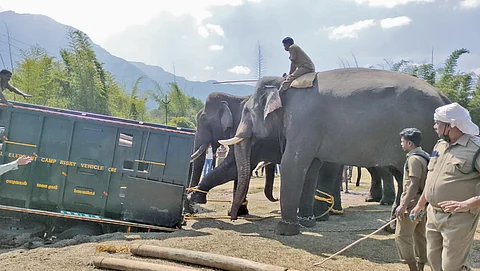

Can elephants be too obese to be healthy? Evidently, they can be. In July 2023, forest officials captured a makhna (tuskless male) elephant in Tamil Nadu’s Coimbatore district and translocated it to Valparai forest in the Western Ghats. During the translocation, they found that the 40-year-old animal weighed 6,000 kg, when the average weight of an elephant his age is 4,500-5,000 kg. The known crop raider was shifted many times before being sent to the forest.
Crop-raider elephants are likely to be obese due to their sedentary lifestyle. “Elephants walk long distances, feeding slowly on leaves and barks over the course of 16-18 hours a day,” says Rajesh Kumar, a forest veterinarian with Mudumalai Tiger Reserve in Tamil Nadu. “But crop-raiding elephants often feed in the same geography and consume a lot of nutrient-rich food in 3-4 hours. They then sleep the rest of the day, allowing fat accumulation,” he explains. Kumar says he has come across four such cases in 2020-23.
India has an estimated 28,000-30,000 elephants, as per Union Ministry of Environment, Forest and Climate Change’s “Elephant Corridors of India 2023” report, and the animal enjoys the highest protection under the Wild Life Protection Act, 1972. But elephants have been found to be increasingly afflicted with diseases associated with humans. For instance, a study published in Emerging Infectious Diseases in 2017 states that three elephant bulls were found infected with tuberculosis (TB) in 2007, 2010 and 2013 in Wayanad Wildlife Sanctuary, Kerala. Reports of TB infections among captive elephants had been reported in India since 1925, but the 2017 paper was the first to confirm the disease in wild populations. Arun Zachariah, a veterinarian who was part of the study, says the animals could acquire TB from humans if they inhale the droplets coughed out by a TB patient or consume TB-infected water from a common source such as pond. “The bacteria is present in the elephant’s trunk. It gets transmitted as the animals use the organ frequently to touch each other,” says Zachariah, explaining TB transmission between elephants. He also says that post 2017, when the study was released, there have been three more cases of TB in wild elephants, raising the total number of cases to six.
International Union for Conservation of Nature’s (IUCN’s) Asian Elephant Specialist Group published a report in 2023-24 stating that captive elephants infected with TB can also spread the disease to wild elephants while sharing grazing lands, during activities such as tourist safaris or cohabitation. “Habitat encroachment and human-elephant conflict brings wild elephants into closer contact with humans, providing increased opportunities for pathogen transmission,” it says. If TB becomes established in the wild, other susceptible species will also be at risk, the report warns.
Postmortems of wild captive elephants have occasionally found presence of elephant endotheliotropic herpesvirus (EEHV)—a haemorrhagic disease with a fatality rate of 85 per cent. According to data with the Central Zoo Authority of India, 12 wild elephants have died due to EEHV in 2009-21. The disease is more prevalent in captive elephants and usually affects the young (up to 15 years of age) with adults acting as carriers, says Zachariah. It spreads through sharing of common sources of water and food, mucosal secretions like saliva, breast milk and nasal and vaginal discharge. Sporadic incidents of EEHV have been reported from Karnataka, Assam and Chhattisgarh. Khanin Changmai, associate coordinator-animal health at global non-profit World Wide Fund for Nature (WWF), Assam, says mass deaths due to such diseases may eventually impact elephant birth rates, fecundity and population in the long term.
Other diseases that have afflicted elephants include anthrax (a bacterial infection that killed three elephants in Tamil Nadu and Assam in 2020-21), rabies (caused by dog bites) and haemorrhagic septicaemia (a bacterial disease that killed six elephants in Odisha’s Karlapat Wildlife Sanctuary in 2021). While anthrax spreads through contaminated soil, water and plants, haemorrhagic septicaemia is found in cattle and water buffalo and usually spreads through water sources.
Close interaction in human dominated landscapes often leads elephants to eat at places such as waste disposal sites, which increases the risk of infection. “Humans consume salt and when elephants eat the processed food from garbage, they get habituated to it. This is clearly a behavioural change,” says NVK Ashraf, chief veterinarian with non-profit Wildlife Trust of India, Thrissur, Kerala.
Changmai says that elephants as a species are more susceptible to transmissible diseases because they primarily interact with the envi-ronment through their trunk. “The trunk and nasal areas become highly exposed to the bacteria or infection that may impact the body,” he notes. The researcher says that free-ranging elephants are known to have inherent diseases, but increased interactions in human-dominated landscapes have made them vulnerable to higher risks, whose true burden and prevalence remains unknown since tracking and checking elephant populations is extremely difficult.
This article was originally published in the May 1-15, 2025 print edition of Down To Earth